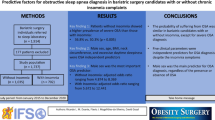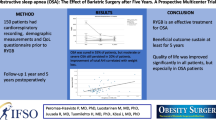Abstract
Background
The patient population that is evaluated for bariatric surgery is characterized by a very high body mass index (BMI). Since obesity is the most important risk factor for obstructive sleep apnea (OSA), sleep disordered breathing is highly prevalent in this population. If undiagnosed before bariatric surgery, untreated OSA can lead to perioperative and postoperative complications. Debate exists whether all patients that are considered for bariatric surgery should undergo polysomnography (PSG) evaluation and screening for OSA as opposed to only those patients with clinical history or examination concerning sleep disordered breathing. We examined the prevalence and severity of OSA in all patients that were considered for bariatric surgery. We hypothesized that, by utilizing preoperative questionnaires (regarding sleepiness and OSA respiratory symptoms) in combination with menopausal status and BMI data, we would be able to predict which subjects did not have sleep apnea without the use of polysomnography. In addition, we hypothesized that we would be able to predict which subjects had severe OSA (apnea–hypopnea index (AHI) > 30).
Methods
Three hundred forty-two consecutive subjects, evaluated for bariatric surgery from November 1, 2005 to January 31, 2007 underwent overnight polysomnography and completed questionnaires regarding sleepiness, menopausal status, and respiratory symptoms related to OSA. Apneas and hypopneas were classified as follows: mild apnea 5 ≤ AHI ≤ 15, moderate apnea 15 < AHI ≤ 30, and severe apnea AHI > 30.
Results
The overall sample prevalence of OSA was 77.2%. Of these, 30.7% had mild OSA; 19.3% had moderate OSA, and 27.2% had severe OSA. Among men, the prevalence of OSA was 93.6% and 73.5% among women. The mean AHI (events per hour) for men with OSA was 49.2 ± 35.5 and 26.3 ± 28.3 for women with OSA. Separate logistic regression models were developed for the following three outcomes: AHI ≥ 5 events per hour, AHI > 15 events per hour, and AHI > 30 events per hour. When predicting these three levels of OSA severity, the area under the curve (AUC) values were: 0.8, 0.72, and 0.8, respectively. The negative predictive value for the presence of sleep apnea (AHI ≥ 5) was 75% when using the most stringent possible cutoff for the prediction model.
Conclusions
The prevalence of OSA in all patients considered for bariatric surgery was greater than 77%, irrespective of OSA symptoms, gender, menopausal status, age, or BMI. The prediction model that we developed for the presence of OSA (AHI ≥ 5 events per hour) has excellent discriminative ability (evidenced by an AUC value of 0.8). However, the negative prediction values for the presence of OSA were too low to be clinically useful due to the high prevalence of OSA in this high-risk group. We demonstrated that, by utilizing even the most stringent possible cutoff values for the prediction model, OSA cannot be predicted with enough certainty. Therefore, we advocate routine PSG testing for all patients that are considered for bariatric surgery.
Similar content being viewed by others
References
Haines KL, Nelson LG, Gonzalez R, et al. Objective evidence that bariatric surgery improves obesity-related obstructive sleep apnea. Surgery. 2007;141:354–8.
O'Keeffe T, Patterson EJ. Evidence supporting routine polysomnography before bariatric surgery. Obes Surg. 2004;14:23–6.
Rasheid S, Banasiak M, Gallagher SF, et al. Gastric bypass is an effective treatment for obstructive sleep apnea in patients with clinically significant obesity. Obes Surg. 2003;13:58–61.
Rechtschaffen A, Kales A. A manual of standardized terminology, techniques and scoring system for sleep stages of human subject. Los Angeles: Univ. of California; 1968.
Johns MW. A new method for measuring daytime sleepiness: the Epworth Sleepiness Scale. Sleep. 1991;14:540–5.
Johns MW. Reliability and factor analysis of the Epworth Sleepiness Scale. Sleep. 1992;15:376–81.
Maislin G, Pack AI, Kribbs NB, et al. A survey screen for prediction of apnea. Sleep. 1995;18:158–66.
Dancey DR, Hanly PJ, Soong C, et al. Impact of menopause on the prevalence and severity of sleep apnea. Chest. 2001;120:151–5.
McKinlay SM, Brambilla DJ, Posner JG. The normal menopause transition. Maturitas. 1992;14:103–15.
Young T, Finn L, Austin D, et al. Menopausal status and sleep-disordered breathing in the Wisconsin Sleep Cohort Study. Am J Respir Crit Care Med. 2003;167:1181–5.
Resta O, Caratozzolo G, Pannacciulli N, et al. Gender, age and menopause effects on the prevalence and the characteristics of obstructive sleep apnea in obesity. Eur J Clin Invest. 2003;33:1084–9.
Resta O, Bonfitto P, Sabato R, et al. Prevalence of obstructive sleep apnoea in a sample of obese women: effect of menopause. Diabetes Nutr Metab. 2004;17:296–303.
Daltro C, Gregorio PB, Alves E, et al. Prevalence and severity of sleep apnea in a group of morbidly obese patients. Obes Surg. 2007;17:809–14.
Redline S, Tishler PV, Hans MG, et al. Racial differences in sleep-disordered breathing in African–Americans and Caucasians. Am J Respir Crit Care Med. 1997;155:186–92.
Hwang D, Shakir N, Limann B, et al. Association of sleep-disordered breathing and postoperative complications. Chest. 2008;133:1128–34.
Author information
Authors and Affiliations
Corresponding author
Appendices
Appendix 1
The Epworth Sleepiness Scale
In contrast to just feeling tired, how likely are you to doze off or fall asleep in the following situations? (This refers to your usual life in recent times. Even if you have not done some of these things recently, try to work out how they would have affected you). Use the following scale to choose the most appropriate number for each situation:
0 = would never doze
1 = slight chance of dozing
2 = moderate chance of dozing
3 = high chance of dozing

Appendix 2
MAP Sleep Symptom–Frequency Questionnaire
During the last month, on how many nights or days per week have you had or been told you had the following (please check only one box per question):

Rights and permissions
About this article
Cite this article
Sareli, A.E., Cantor, C.R., Williams, N.N. et al. Obstructive Sleep Apnea in Patients Undergoing Bariatric Surgery—A Tertiary Center Experience. OBES SURG 21, 316–327 (2011). https://doi.org/10.1007/s11695-009-9928-1
Received:
Accepted:
Published:
Issue Date:
DOI: https://doi.org/10.1007/s11695-009-9928-1




